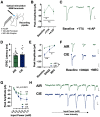Chronic Intermittent Ethanol Exposure Dysregulates Nucleus Basalis Magnocellularis Afferents in the Basolateral Amygdala
- PMID: 36280288
- PMCID: PMC9668348
- DOI: 10.1523/ENEURO.0164-22.2022
Chronic Intermittent Ethanol Exposure Dysregulates Nucleus Basalis Magnocellularis Afferents in the Basolateral Amygdala
Abstract
Nucleus basalis magnocellularis (NBM) cholinergic projections to the basolateral amygdala (BLA) regulate the acquisition and consolidation of fear-like and anxiety-like behaviors. However, it is unclear whether the alterations in the NBM-BLA circuit promote negative affect during ethanol withdrawal (WD). Therefore, we performed ex vivo whole-cell patch-clamp electrophysiology in both the NBM and the BLA of male Sprague Dawley rats following 10 d of chronic intermittent ethanol (CIE) exposure and 24 h of WD. We found that CIE exposure and withdrawal enhanced the neuronal excitability of NBM putative "cholinergic" neurons. We subsequently used optogenetics to directly manipulate NBM terminal activity within the BLA and measure cholinergic modulation of glutamatergic afferents and BLA pyramidal neurons. Our findings indicate that CIE and withdrawal upregulate NBM cholinergic facilitation of glutamate release via activation of presynaptic nicotinic acetylcholine receptors (AChRs). Ethanol withdrawal-induced increases in NBM terminal activity also enhance BLA pyramidal neuron firing. Collectively, our results provide a novel characterization of the NBM-BLA circuit and suggest that CIE-dependent modifications to NBM afferents enhance BLA pyramidal neuron activity during ethanol withdrawal.
Keywords: GABA; acetylcholine; amygdala; basal forebrain; ethanol; glutamate.
Copyright © 2022 Sizer et al.
Conflict of interest statement
The authors declare no competing financial interests.
Figures







Similar articles
-
Chronic Ethanol Exposure Potentiates Cholinergic Neurotransmission in the Basolateral Amygdala.Neuroscience. 2021 Feb 10;455:165-176. doi: 10.1016/j.neuroscience.2020.12.014. Epub 2020 Dec 29. Neuroscience. 2021. PMID: 33385490 Free PMC article.
-
Chronic Ethanol Differentially Modulates Glutamate Release from Dorsal and Ventral Prefrontal Cortical Inputs onto Rat Basolateral Amygdala Principal Neurons.eNeuro. 2020 Mar 6;7(2):ENEURO.0132-19.2019. doi: 10.1523/ENEURO.0132-19.2019. Print 2020 Mar/Apr. eNeuro. 2020. PMID: 31548367 Free PMC article.
-
Withdrawal from chronic ethanol exposure increases postsynaptic glutamate function of insular cortex projections to the rat basolateral amygdala.Neuropharmacology. 2020 Aug 1;172:108129. doi: 10.1016/j.neuropharm.2020.108129. Epub 2020 May 8. Neuropharmacology. 2020. PMID: 32418906 Free PMC article.
-
The role of basal forebrain cholinergic neurons in fear and extinction memory.Neurobiol Learn Mem. 2016 Sep;133:39-52. doi: 10.1016/j.nlm.2016.06.001. Epub 2016 Jun 2. Neurobiol Learn Mem. 2016. PMID: 27264248 Free PMC article. Review.
-
Basolateral amygdala, nicotinic cholinergic receptors, and nicotine: Pharmacological effects and addiction in animal models and humans.Eur J Neurosci. 2019 Aug;50(3):2247-2254. doi: 10.1111/ejn.13970. Epub 2018 Aug 31. Eur J Neurosci. 2019. PMID: 29802666 Review.
Cited by
-
Operant ethanol self-administration behaviors do not predict sex differences in continuous access home cage drinking.Alcohol. 2025 Mar;123:87-99. doi: 10.1016/j.alcohol.2024.08.004. Epub 2024 Aug 31. Alcohol. 2025. PMID: 39218047
-
Distinct cholinergic circuits underlie discrete effects of reward on attention.Front Mol Neurosci. 2024 Aug 29;17:1429316. doi: 10.3389/fnmol.2024.1429316. eCollection 2024. Front Mol Neurosci. 2024. PMID: 39268248 Free PMC article. Review.
References
-
- Aitta-Aho T, Hay YA, Phillips BU, Saksida LM, Bussey TJ, Paulsen O, Apergis-Schoute J (2018) Basal forebrain and brainstem cholinergic neurons differentially impact amygdala circuits and learning-related behavior. Curr Biol 28:2557–2569.e4. - PubMed
-
- Alonso A, Khateb A, Fort P, Jones BE, Mühlethaler M (1996) Differential oscillatory properties of cholinergic and noncholinergic nucleus basalis neurons in guinea pig brain slice. Eur J Neurosci 8:169–182. - PubMed
-
- Arieli E, Gerbi R, Shein-Idelson M, Moran A (2020) Temporally-precise basolateral amygdala activation is required for the formation of taste memories in gustatory cortex. J Physiol 598:5505–5522. - PubMed
MeSH terms
Substances
Grants and funding
LinkOut - more resources
Full Text Sources
